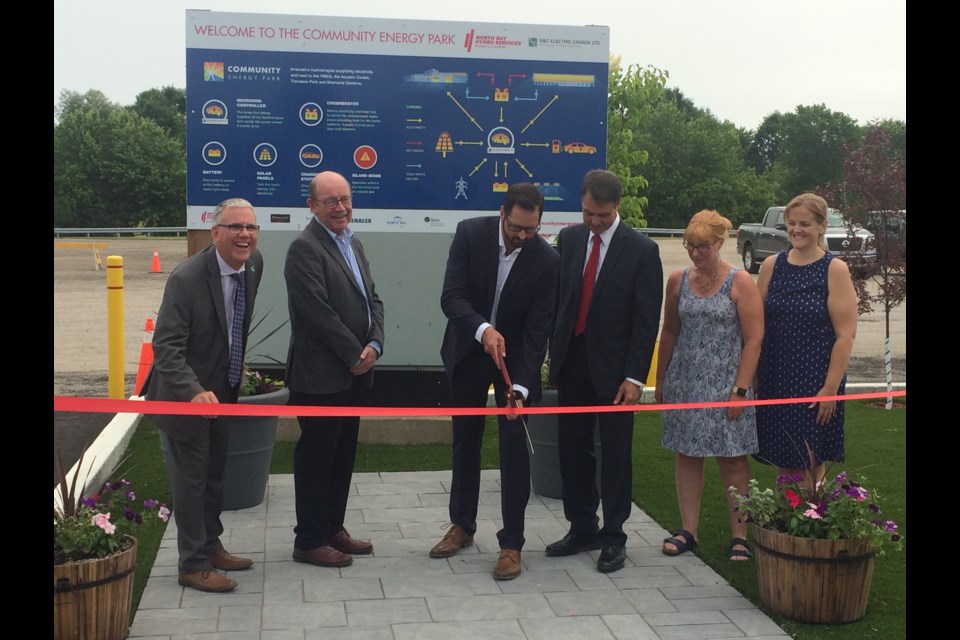North Bay can now lay claim to having the first utility-scale microgrid in Canada and the first resiliency hub in North America.
“This project is one we’re particularly proud of not only for its innovation, but for what it means to the community and the environment, “said Paul McMullen vice-president of S&C Electric Canada.
Speaking at the official opening of North Bay’s Community Energy Park, McMullen told the crowd that the stakeholders recognize how impactful the Community Park Microgrid is to the city and the future of energy delivery.
Project partners include North Bay Hydro Services, ieso, (Independent Electricity System Operator) and S&C Electric Company.
Located between the YMCA and Memorial Gardens, the microgrid provides heat and electricity to both facilities as well as Thomson Park.
The microgrid is powered by two 265-kW natural gas generators, 9-kW of solar, 7- kW of rooftop panels and a 2kW solar flower.
“The flower is solar panels. It is three kilowatts of solar energy that gets produced. It’s like a flower that nests at night and as the sun comes up, it would open up like a flower would and it tracks the sun the entire day. It is the showcase,” explained Matt Payne president and Chief Operating Officer of North Bay Hydro Services.
“In the event of a major power outage, it will create self-sustaining power for both the facilities. It will keep the heat on, it will keep the lights on, creating a warm and safe environment in those catastrophic situations. Even just if the lights go out locally to these locations, this will pick up and provide that power at all times. It is very smart. It does it automatically. It doesn’t need any human intervention.”
The total cost of the project is $4.5 million, with over 60 per cent funded through government grants and funds, including $1 million from the province.
Nipissing-Timiskaming MP Anthony Rota said it was two years ago when he was first approached about the idea.
The federal government has invested about $750,000 into the project.
” It is about security in the lives of people and of course saving money.”
The City of North Bay contributed $261,000 in capital as its commitment towards ensuring the project moved ahead.
Deputy Mayor Tanya Vrebosch said should North Bay experience a major power outage due to a severe winter or summer storm or some other disaster, the city would rely on the energy park for backup.
“In an emergency situation there is always a place for the citizens of North Bay to go because we have the YMCA and the Memorial Gardens that are going to be up and running with heat and electricity,” said Vrebosch.
In the event of a major power outage, it will create self-sustaining power for both the facilities “in perpetuity” because it is self-sustaining.
“We do these kinds of projects. We have a generator at the North Bay Regional Health Centre, we have a generator at the Merrick Landfill, and again it is just moving it forward, trying new technology, seeing how it can help,” said Payne.
“We looked at this from a resiliency and efficiency point of view and to get this technology in and working. This is the future. We’ve got to start doing this differently and North Bay Hydro Services, our energy company, wants to be a leader in that and be able to provide these solutions to customers. So that’s why we got into it.”
The microgrid is expected to greatly improve the city’s overall power efficiency.
“In certain situations, it is providing probably about 87 per cent of the total power these facilities consume on an annual basis, and about 55 per cent of the heat is being generated right here on an annual basis. But on any given day, it can be doing all those requirements, ” said Payne who went on to explain that there is still a connection to the grid from which it takes limited power but in a situation where they need to shut down, there will be full grid power again.
“It is also going to be a demonstration and education site. We’re going to bring people here to learn about this, so it is going to have that element to it as well which is really important.”
Terry Young vice president with Independent Electricity System Operator (ieso) a project partner says it is a good indicator of where the utility system is going, where some of the innovation is taking place.
“You look at how all the resources work together, the resiliency that is here. When we look at this and the ability for others to learn from this, that is really important to us too. The sector is changing so much with new technology and the advance of new technologies coming on, for others to learn from this is absolutely terrific.”
There are many conversations going on about how to move forward.
“It wasn’t so long ago the way the system was built, you would have a very major plant producing a lot of electricity at the end of a very long line. Now we’re seeing more technologies pop up where you’re seeing solar, you’re seeing battery, you’re seeing other types that are popping up closer to where the communities are and right in the communities themselves,” said Young.
“So, we’re seeing that ability for communities to support themselves and in the way, they want to. So that is what is really neat about this project. In perspective to where Ontario is, where North Bay is, is where others are trying to get to. Yes, there has been a lot of development, a lot of innovation that has gone into this, but this will be valuable learning for others who are trying to do exactly the same thing.”
The project has already caught the attention of other communities and utilities with inquiries coming in from across the country.



